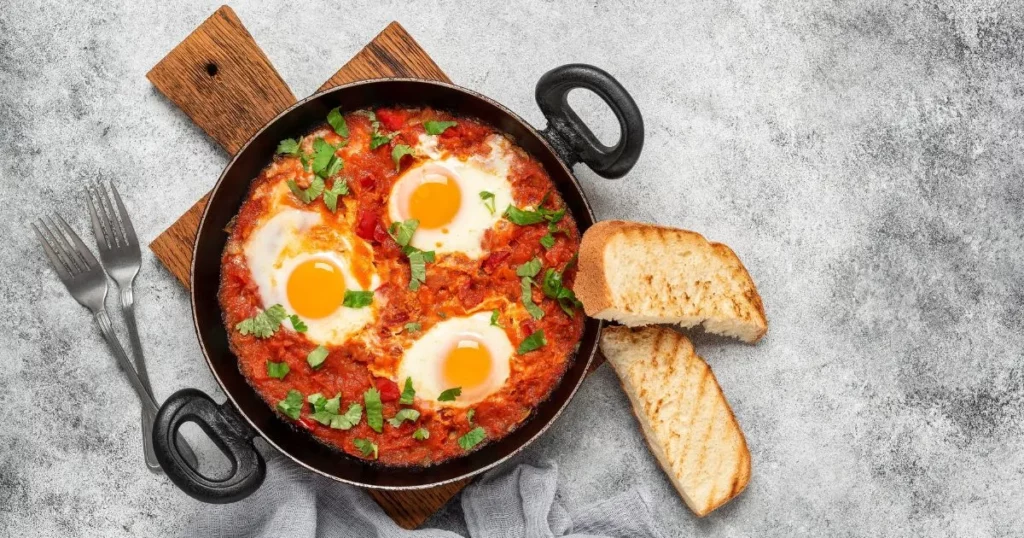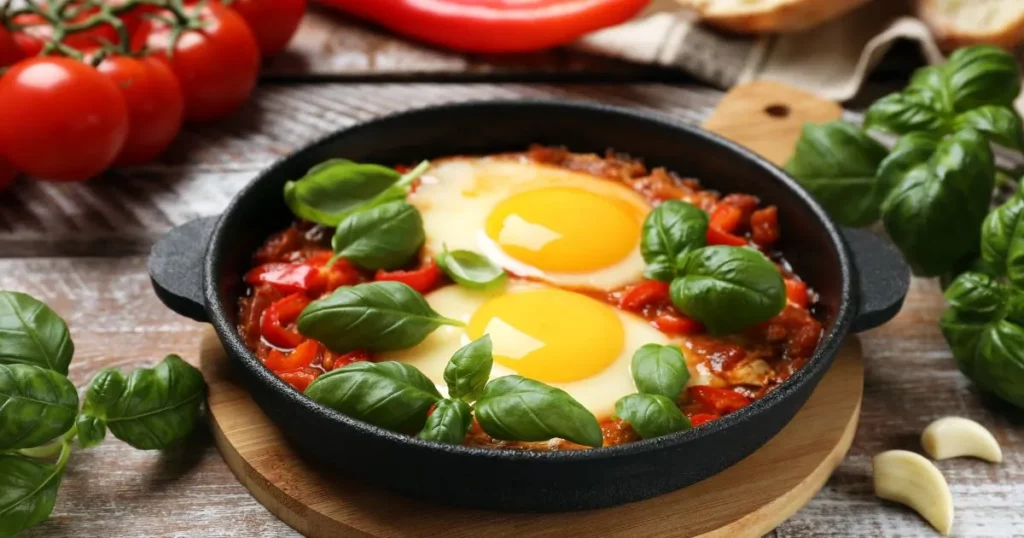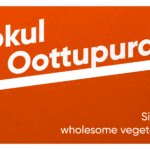There’s something oddly comforting about cracking eggs into a pan of bubbling, spiced tomato sauce and watching them poach just right, whites set, yolks still gloriously runny. That, my friends, is the magic of Shakshuka. A dish that feels fancy, tastes exotic, and yet is so simple you can whip it up on a lazy morning with whatever’s left in your fridge.

But Shakshuka is more than just a viral brunch darling. It has roots, stories, culture, and yes, spice levels that can bring a tear to your eye (both from the heat and the nostalgia). So buckle up: whether you’re a tomato-lover, an egg enthusiast, or just here for the food facts, let’s dig into the shakshuka origin, its journey, and why it deserves a permanent place in your breakfast rotation.
What is Shakshuka?

Before we get into history books and passport stamps, let’s cover the basics. Shakshuka is a dish consisting poached eggs, spiced tomato and pepper sauce. Sounds simple, right? But when done right, it’s a flavor bomb that hits sweet, smoky, spicy, and savory all at once.
The standard line-up of ingredients includes:
- Ripe tomatoes or canned ones (nobody’s judging),
- Onions and garlic,
- Bell peppers,
- A generous pour of olive oil,
- Spices like paprika, cumin, cayenne, and black pepper,
- And of course, eggs
You can toss in extras like feta, spinach, or even merguez sausage if you’re feeling wild. Some regions use harissa for added kick. Some go heavy on herbs like parsley and coriander. That’s the beauty of Shakshuka, it’s endlessly customizable.
Whether served in cast-iron skillets or ladled into bowls, one thing remains constant: it’s a dish that brings people together, usually over bread to scoop every last bit.
The Origin of Shakshuka

Let’s answer the big question first: what is the shakshuka origin country?
While it’s often associated with Middle Eastern cuisine, the true shakshuka origin lies in North Africa, particularly Tunisia and Libya. The name “Shakshuka” itself is believed to come from Arabic, meaning “a mixture”, a pretty accurate description for this humble mashup of eggs and tomatoes.
In Tunisia, it was a working-class dish. Affordable, easy to make, and packed with flavor. Think of it as the North African cousin to Italian caponata or Indian masala eggs. From there, it traveled across borders and cultures, getting adopted and adapted along the way.
History of Shakshuka Through Time

North Africa – The Starting Point
In its earliest forms, Shakshuka was all about simplicity: tomatoes, garlic, spices, and eggs. Cooked slowly and served with bread, it was a nourishing meal that didn’t break the bank. In Tunisia and Libya, the dish was often served with lamb or spicy sausage, making it heartier.
But it wasn’t just a recipe. It was part of the rhythm of daily life. The origin of shakshuka is deeply rooted in this sense of community and resourcefulness.
Migration to the Middle East
The history of shakshuka took a sharp turn during the mid-20th century when Jewish communities from North Africa migrated to Israel. They brought the dish with them—and it absolutely took off.
Why? Because it fit perfectly into the Israeli food culture: fresh, spicy, and easy to make in large batches. Israeli-style Shakshuka became a thing. Served in cafés, garnished with tahini or labneh, and eaten with warm pita, it quickly became a breakfast staple.
And this version added even more variations: green Shakshuka with spinach and herbs, red Shakshuka with chilies and tomato paste, even vegan takes using tofu instead of eggs. That’s when shakshuka history really started making global headlines.
Shakshuka’s Global Rise
Fast-forward a few decades, and suddenly Shakshuka was everywhere, from hipster brunch menus in London to food trucks in New York. It became that one dish every food blogger tried at least once and every home cook attempted on a slow Sunday morning.
Why the popularity? For starters, it looks stunning. The contrast of bright eggs against red sauce is practically begging for an Instagram post. But more than that, it’s deeply comforting. It ticks all the boxes: warm, hearty, spicy, and versatile.
Chefs in Paris gave it a French flair with goat cheese. Brooklyn cafes paired it with sourdough. And the internet exploded with variations, from mushroom shakshuka to cheese-loaded versions that are basically pizza with eggs.
Western Adaptations
Now we’re seeing shakshuka in places it never expected to go. Breakfast sandwiches with shakshuka-style eggs. Frozen food versions for microwave lovers. I even saw a shakshuka pizza (which was actually… amazing).
But through all these reinventions, the heart of it remains the same: that rustic, tomatoey goodness with runny eggs and a smoky kick. The shakshuka origin country might be Tunisia, but the world has fully adopted and adored it.
Cultural Importance of Shakshuka

One of the coolest things about shakshuka history is how it reflects cultural blending. Every region that adopted shakshuka gave it a unique twist, whether through spices, serving style, or accompaniments.
In Tunisia, it’s paired with spicy harissa. In Israel, it’s got za’atar or tahini. In Morocco, they might add olives and preserved lemon. And now, you can even find versions with Indian spices like garam masala or South American beans.
It shows how something simple can cross borders and become something new every time, without losing its roots.
Savor the Taste of Shakshuka Today – Order Easily via Swiggy

Okay, okay, all this talk about tomatoes, eggs, and spices… I know you’re hungry. If your pantry isn’t stocked for a home-cooked shakshuka moment, don’t stress. Just order food delivery through Swiggy and get your shakshuka fix from some of the top-rated cafes and restaurants near you.
Whether you like it fiery, mild, herby, or topped with feta, there’s a version out there calling your name. And let’s be honest: this is one mess you want to get into.
Conclusion

Shakshuka may have humble beginnings, but it’s now a global superstar. What started as a simple, tomato-and-egg breakfast from North Africa is now beloved around the world, without losing its soul.
Whether you’re scooping it up with crusty bread in a busy Tel Aviv café or spooning it out of a cast iron skillet in your own kitchen, shakshuka origin stories travel with every bite. It’s hearty, adaptable, and full of culture, just like the best kinds of food.
So next time you’re stuck wondering what to cook, or where to eat, remember this spicy, saucy, eggy marvel. Shakshuka isn’t just a meal. It’s a vibe.
FAQs
1. How is traditional shakshuka different from modern versions?
Traditional shakshuka keeps it simple: tomatoes, onions, garlic, and eggs. Modern versions go wild with toppings like cheese, spinach, mushrooms, or even tofu. Some even ditch tomatoes altogether for green or white shakshuka styles. The base remains, but chefs love playing with the formula.
2. Is Shakshuka a vegetarian dish?
Yes! At its core, shakshuka is vegetarian, no meat involved. It’s typically made with veggies, spices, and eggs. That said, some modern versions add sausage or meat, so always check before diving in.
3. What spices are used in traditional Shakshuka?
Classic shakshuka spices include cumin, paprika, chili flakes or cayenne, and black pepper. Some regions also use harissa for extra heat and depth. It’s this spice mix that gives shakshuka its signature warmth and flavor profile.
Author Bio
Satisfying your cravings, one bite at a time. Discover the best eats, trends, and uncover the hidden gems with us to make your online ordering or dining experience a memorable one.



















































































